Spatiotemporal Analysis of Economic and Ecological Coupled Coordination: A Case Study of the Beijing–Tianjin–Hebei Urban Agglomeration
Abstract
:1. Introduction
2. Materials and Methods
2.1. Study Area
2.2. Data Sources
2.3. Construction of the Evaluation Index System
2.4. Estimation of Ecosystem Services
2.4.1. Water Conservation
2.4.2. Soil Conservation
2.4.3. Sand Fixation
2.5. Comprehensive Development Level Model
2.6. Coupled Coordination Degree Model
3. Results
3.1. Status of Characterization between RE and EQ Indicators
3.2. Evolution of the Characteristics of RE and EQ Indicators
3.3. Coupled and Coordinated Evolution of RE and EQ
4. Discussion
5. Conclusions
Author Contributions
Funding
Data Availability Statement
Acknowledgments
Conflicts of Interest
References
- Salvati, L.; Carlucci, M. Zero Net Land Degradation in Italy: The role of socioeconomic and agro-forest factors. J. Environ. Manag. 2014, 145, 299–306. [Google Scholar] [CrossRef] [PubMed]
- Wang, S.; Zhang, X.; Wu, T.; Yang, Y. The evolution of landscape ecological security in Beijing under the influence of different policies in recent decades. Sci. Total Environ. 2019, 646, 49–57. [Google Scholar] [CrossRef]
- Li, J.; Ren, Z.; Zhou, Z. Quantitative analysis of the dynamic change and spatial differences of the ecological security: A case study of Loess Plateau in northern Shaanxi Province. J. Geogr. Sci. 2006, 16, 251–256. [Google Scholar] [CrossRef]
- Yao, L.; Ma, R.; Liao, Z.; Du, S.; Jin, M.; Ren, P. Optimization and simulation of tourist shunt scheme: A case of Jiuzhai Valley. Chaos Solitons Fractals 2016, 89, 455–464. [Google Scholar] [CrossRef]
- Walker, K.; Ni, N.; Huo, W. Is the Red Dragon Green? An Examination of the Antecedents and Consequences of Environmental Proactivity in China. J. Bus. Ethics 2014, 125, 27–43. [Google Scholar] [CrossRef]
- Deng, Z.; Song, S.; Jiang, N.; Pang, R. Sustainable development in China? A nonparametric decomposition of economic growth. China Econ. Rev. 2023, 81, 102041. [Google Scholar] [CrossRef]
- Liu, W.; Jiao, F.; Ren, L.; Xu, X.; Wang, J.; Wang, X. Coupling coordination relationship between urbanization and atmospheric environment security in Jinan City. J. Clean. Prod. 2018, 204, 1–11. [Google Scholar] [CrossRef]
- de Oliveira, J.A.P.; Doll, C.N.H.; Balaban, O.; Jiang, P.; Dreyfus, M.; Suwa, A.; Moreno-Penaranda, R.; Dirgahayani, P. Green economy and governance in cities: Assessing good governance in key urban economic processes. J. Clean. Prod. 2013, 58, 138–152. [Google Scholar] [CrossRef]
- Shen, L.; Shu, T.; Liao, X.; Yang, N.; Ren, Y.; Zhu, M.; Cheng, G.; Wang, J. A new method to evaluate urban resources environment carrying capacity from the load-and-carrier perspective. Resour. Conserv. Recycl. 2020, 154, 104616. [Google Scholar] [CrossRef]
- Zhang, D.; Huang, Q.; He, C.; Wu, J. Impacts of urban expansion on ecosystem services in the Beijing-Tianjin-Hebei urban agglomeration, China: A scenario analysis based on the Shared Socioeconomic Pathways. Resour. Conserv. Recycl. 2017, 125, 115–130. [Google Scholar] [CrossRef]
- Fang, C.; Zhou, C.; Gu, C.; Chen, L.; Li, S. A proposal for the theoretical analysis of the interactive coupled effects between urbanization and the eco-environment in mega-urban agglomerations. J. Geogr. Sci. 2017, 27, 1431–1449. [Google Scholar] [CrossRef]
- Liu, L.; Caloz, C.; Chang, C.C.; Itoh, T. Forward coupling phenomena between artificial left-handed transmission lines. J. Appl. Phys. 2002, 92, 5560–5565. [Google Scholar] [CrossRef]
- Norgaard, R.B. Economic indicators of resource scarcity: A critical essay. J. Environ. Econ. Manag. 1990, 19, 19–25. [Google Scholar] [CrossRef]
- Fan, Y.; Qiao, Q.; Fang, L.; Yao, Y. Emergy analysis on industrial symbiosis of an industrial park-A case study of Hefei economic and technological development area. J. Clean. Prod. 2017, 141, 791–798. [Google Scholar] [CrossRef]
- Shi, X.; Yang, J. A material flow-based approach for diagnosing urban ecosystem health. J. Clean. Prod. 2014, 64, 437–446. [Google Scholar] [CrossRef]
- Fang, C.; Liu, H.; Li, G. International progress and evaluation on interactive coupling effects between urbanization and the eco-environment. J. Geogr. Sci. 2016, 26, 1081–1116. [Google Scholar] [CrossRef]
- Guo, L. Coupling Coordination Degree between New Urbanization and Eco-Environment in Shaanxi, China, and Its Influencing Factors. Discret. Dyn. Nat. Soc. 2021, 2021, 1555362. [Google Scholar] [CrossRef]
- Yang, Z.; Zhan, J.; Wang, C.; Twumasi-Ankrah, M.J. Coupling coordination analysis and spatiotemporal heterogeneity between sustainable development and ecosystem services in Shanxi Province, China. Sci. Total Environ. 2022, 836, 155625. [Google Scholar] [CrossRef]
- Zhang, Z.; Li, Y. Coupling coordination and spatiotemporal dynamic evolution between urbanization and geological hazards?A case study from China. Sci. Total Environ. 2020, 728, 138825. [Google Scholar] [CrossRef] [PubMed]
- Cai, J.; Li, X.; Liu, L.; Chen, Y.; Wang, X.; Lu, S. Coupling and coordinated development of new urbanization and agro-ecological environment in China. Sci. Total Environ. 2021, 776, 145837. [Google Scholar] [CrossRef] [PubMed]
- Cheng, J.; Zhang, X.; Gao, Q. Analysis of the spatio-temporal changes and driving factors of the marine economic-ecological-social coupling coordination: A case study of 11 coastal regions in China. Ecol. Indic. 2023, 153, 110392. [Google Scholar] [CrossRef]
- He, S.; Shao, X. Spatial Clustering and Coupling Coordination of Population-Land-Economic Urbanization in Beijing-Tianjin-Hebei Region. Econ. Geogr. 2018, 38, 95–102. [Google Scholar]
- Li, J.; Sun, W.; Li, M.; Meng, L. Coupling coordination degree of production, living and ecological spaces and its influencing factors in the Yellow River Basin. J. Clean. Prod. 2021, 298, 126803. [Google Scholar] [CrossRef]
- Wang, Y.-h.; Li, J.-y. Coupling coordination evaluation method between eco-environment quality and economic development level in contiguous special poverty-stricken areas of China. Ying Yong Sheng Tai Xue Bao = J. Appl. Ecol. 2015, 26, 1519–1530. [Google Scholar]
- Xu, L.; Chen, S.S. Coupling coordination degree between social-economic development and water environment: A case study of Taihu lake basin, China. Ecol. Indic. 2023, 148, 110118. [Google Scholar] [CrossRef]
- Fan, Y.; Fang, C.; Zhang, Q. Coupling coordinated development between social economy and ecological environment in Chinese provincial capital cities-assessment and policy implications. J. Clean. Prod. 2019, 229, 289–298. [Google Scholar] [CrossRef]
- Zhu, X.; Xue, L. Changes of ecological service value and its coupling with economic development in Guanzhong region. Chin. J. Ecol. 2022, 41, 769–776. [Google Scholar]
- Chen, J.; Zhang, W.; Song, L.; Wang, Y. The coupling effect between economic development and the urban ecological environment in Shanghai port. Sci. Total Environ. 2022, 841, 156734. [Google Scholar] [CrossRef] [PubMed]
- Liao, M.L.; Chen, Y.; Wang, Y.J.; Lin, M.S. Study on the coupling and coordination degree of high-quality economic development and ecological environmet in beijing-tianjin-hebei region. Appl. Ecol. Environ. Res. 2019, 17, 11069–11083. [Google Scholar] [CrossRef]
- Yang, Y.; Li, X.; Dong, W.; Poon, P.H.J.; Hong, H.; He, Z.; Liu, Y. Assessing China’s human-environment relationship. J. Geogr. Sci. 2019, 29, 1261–1282. [Google Scholar] [CrossRef]
- Fang, C.; Wang, Z.; Xu, G. Spatial-temporal characteristics of PM2.5 in China: A city-level perspective analysis. J. Geogr. Sci. 2016, 26, 1519–1532. [Google Scholar] [CrossRef]
- Li, Q.; Li, W.; Wang, S.; Wang, J. Assessing heterogeneity of trade-offs/synergies and values among ecosystem services in Beijing-Tianjin-Hebei urban agglomeration. Ecol. Indic. 2022, 140, 109026. [Google Scholar] [CrossRef]
- Liang, L.; Wang, Z.; Li, J. The effect of urbanization on environmental pollution in rapidly developing urban agglomerations. J. Clean. Prod. 2019, 237, 117649. [Google Scholar] [CrossRef]
- Wu, A.; Zhang, J.; Zhao, Y.; Shen, H.; Guo, X. Simulation and Optimization of Supply and Demand Pattern of Multiobjective Ecosystem Services-A Case Study of the Beijing-Tianjin-Hebei Region. Sustainability 2022, 14, 2658. [Google Scholar] [CrossRef]
- Liao, W.; Yu, J.; Yuan, R. Coupling synergy between poverty alleviation and rural revitalization: A comparison between poverty alleviation counties (cities) based on different time series. China Popul. Resour. Environ. 2020, 30, 132–142. [Google Scholar]
- Liu, Y.S.; Liu, J.L.; Zhou, Y. Spatio-temporal patterns of rural poverty in China and targeted poverty alleviation strategies. J. Rural. Stud. 2017, 52, 66–75. [Google Scholar] [CrossRef]
- He, J.; Li, T.R.; Chen, L.; Gao, Y.W. The impact of poverty alleviation policy on the industrial structure: Evidence from the Qinba Mountain contiguous poverty-stricken areas. Heliyon 2024, 10, e30151. [Google Scholar] [CrossRef]
- Wu, M.Z.; Zhang, P.L. Poverty alleviation and pollution reduction: Evidence from the poverty hat removal program in China. Struct. Change Econ. Dyn. 2024, 70, 56–76. [Google Scholar] [CrossRef]
- Duan, W.Q.; Jiang, M.M.; Qi, J.H. Agricultural certification, market access and rural economic growth: Evidence from poverty-stricken counties in China. Econ. Anal. Policy 2024, 81, 99–114. [Google Scholar] [CrossRef]
- Ge, Y.; Hu, S.; Song, Y.Z.; Zheng, H.; Liu, Y.S.; Ye, X.Y.; Ma, T.; Liu, M.X.; Zhou, C.H. Sustainable poverty reduction models for the coordinated development of the social economy and environment in China. Sci. Bull. 2023, 68, 2236–2246. [Google Scholar] [CrossRef]
- Meng, G.; Wang, K.Y.; Wang, F.Y.; Dong, Y.J. Analysis of the tourism-economy-ecology coupling coordination and high-quality development path in karst Guizhou Province, China. Ecol. Indic. 2023, 154, 110858. [Google Scholar] [CrossRef]
- Chen, Q.W.; Lu, S.X.; Xiong, K.N.; Zhao, R. Coupling analysis on ecological environment fragility and poverty in South China Karst. Environ. Res. 2021, 201, 111650. [Google Scholar] [CrossRef]
- Liu, H.; Ma, L.; Li, G. Spatial-temporal evolution pattern of unbalanced economic development in Beijing-Tianjin-Hebei region since the 1990s. Geogr. Res. 2016, 35, 471–481. [Google Scholar]
- Qi, Y.; Yang, Y.; Jin, F. China’s economic development stage and its spatio-temporal evolution: A prefectural-level analysis. J. Geogr. Sci. 2013, 23, 297–314. [Google Scholar] [CrossRef]
- Liu, J.; Kuang, W.; Zhang, Z.; Xu, X.; Qin, Y.; Ning, J.; Zhou, W.; Zhang, S.; Li, R.; Yan, C.; et al. Spatiotemporal characteristics, patterns, and causes of land-use changes in China since the late 1980s. J. Geogr. Sci. 2014, 24, 195–210. [Google Scholar] [CrossRef]
- Zhang, Y.; Yu, G.; Yang, J.; Wimberly, M.C.; Zhang, X.; Tao, J.; Jiang, Y.; Zhu, J. Climate-driven global changes in carbon use efficiency. Glob. Ecol. Biogeogr. 2014, 23, 144–155. [Google Scholar] [CrossRef]
- Zhao, M.S.; Heinsch, F.A.; Nemani, R.R.; Running, S.W. Improvements of the MODIS terrestrial gross and net primary production global data set. Remote Sens. Environ. 2005, 95, 164–176. [Google Scholar] [CrossRef]
- Zhen, L.; Hu, Y.; Wei, Y.; Luo, Q.; Han, Y. Trend of ecological degradation and restoration technology requirement in typical ecological vulnerable regions. Resour. Sci. 2019, 41, 63–74. [Google Scholar]
- Cleland, E. Biodiversity and ecosystem stability. Nat. Educ. Knowl. 2012, 3, 14. [Google Scholar]
- Costanza, R.; Mageau, M. What is a healthy ecosystem? Aquat. Ecol. 1999, 33, 105–115. [Google Scholar] [CrossRef]
- Zhao, T.; Ou, Y.; Zheng, H.; Wang, X.; Miao, H. Forest ecosystem services and their valuation in China. J. Nat. Resour. 2004, 19, 480–491. [Google Scholar]
- Huang, L.; Cao, W.; Xu, X.; Fan, J.; Wang, J. Linking the benefits of ecosystem services to sustainable spatial planning of ecological conservation strategies. J. Environ. Manag. 2018, 222, 385–395. [Google Scholar] [CrossRef]
- Zhang, W.; Xie, Y.; Liu, B. Rainfall Erosivity Estimation Using Daily Rainfall Amounts. Sci. Geogr. Sin. 2002, 22, 705–711. [Google Scholar]
- Wischmeier, W.H.; Johnson, C.B.; Cross, B.V. Soil erodibility nomograph for farmland and construction sites. J. Soil. Water Conserv. 1971, 26, 189–193. [Google Scholar]
- Liu, B.Y.; Nearing, M.A.; Risse, L.M. Slope gradient effects on soil loss for steep slopes. Trans. Asae 1994, 37, 1835–1840. [Google Scholar] [CrossRef]
- McCool, D.K.; Brown, L.C.; Foster, G.R.; Mutchler, C.K.; Meyer, L.D. Revised slope steepness factor for the universal soil loss equation. Trans. Asae 1987, 30, 1387–1396. [Google Scholar] [CrossRef]
- Cai, C.; Ding, S.; Shi, Z.; Huang, L.; Zhang, G. Study of Applying USLE and Geographical Information System IDRISI to Predict Soil Erosion in Small Watershed. J. Soil. Water Conserv. 2000, 14, 19–24. [Google Scholar]
- Cao, W.; Wu, D.; Huang, L.; Liu, L. Spatial and temporal variations and significance identification of ecosystem services in the Sanjiangyuan National Park, China. Sci. Rep. 2020, 10, 6151. [Google Scholar] [CrossRef]
- Wang, S.; Shi, H.; Xu, X.; Huang, L.; Gu, Q.; Liu, H. County zoning and optimization paths for trade-offs and synergies of ecosystem services in Northeast China. Ecol. Indic. 2024, 164, 112044. [Google Scholar] [CrossRef]
- Zhang, H.; Fan, J.; Cao, W.; Harris, W.; Li, Y.; Chi, W.; Wang, S. Response of wind erosion dynamics to climate change and human activity in Inner Mongolia, China during 1990 to 2015. Sci. Total Environ. 2018, 639, 1038–1050. [Google Scholar] [CrossRef] [PubMed]
- Liu, F.; Wang, C.; Luo, M.; Zhou, S.; Liu, C. An investigation of the coupling coordination of a regional agricultural economics-ecology-society composite based on a data-driven approach. Ecol. Indic. 2022, 143, 109363. [Google Scholar] [CrossRef]
- Zhang, Y.; Zhang, Y.; Zhang, H.; Zhang, Y. Evaluation on new first-tier smart cities in China based on entropy method and TOPSIS. Ecol. Indic. 2022, 145, 109616. [Google Scholar] [CrossRef]
- Zhang, H.; Gu, C.L.; Gu, L.W.; Zhang, Y. The evaluation of tourism destination competitiveness by TOPSIS & information entropy-A case in the Yangtze River Delta of China. Tour. Manag. 2011, 32, 443–451. [Google Scholar] [CrossRef]
- Zou, C.; Zhu, J.; Lou, K.; Yang, L. Coupling coordination and spatiotemporal heterogeneity between urbanization and ecological environment in Shaanxi Province, China. Ecol. Indic. 2022, 141, 109152. [Google Scholar] [CrossRef]
- Deng, J.; Chen, T.; Zhang, Y. Effect of Collaborative Innovation on High-Quality Economic Development in Beijing-Tianjin-Hebei Urban Agglomeration-An Empirical Analysis Based on the Spatial Durbin Model. Mathematics 2023, 11, 1909. [Google Scholar] [CrossRef]
- An, H.-M.; Xiao, C.-D.; Tong, Y.; Fan, J. Ice-and-snow tourism and its sustainable development in China: A new perspective of poverty alleviation. Adv. Clim. Change Res. 2021, 12, 881–893. [Google Scholar] [CrossRef]
- He, J.; Ren, F.; Weibel, R.; Fu, C. The effect of large scale photovoltaic-based projects on poverty reduction: Empirical evidence from China. Renew. Energy 2023, 218, 119294. [Google Scholar] [CrossRef]
- Leng, G.-X.; Feng, X.-L.; Qiu, H.-G. Income effects of poverty alleviation relocation program on rural farmers in China. J. Integr. Agric. 2021, 20, 891–904. [Google Scholar] [CrossRef]
- Zhou, L.; Xiong, L.-Y. Natural topographic controls on the spatial distribution of poverty-stricken counties in China. Appl. Geogr. 2018, 90, 282–292. [Google Scholar] [CrossRef]
- Feng, Z.; Jin, X.; Chen, T.; Wu, J. Understanding trade-offs and synergies of ecosystem services to support the decision-making in the Beijing?Tianjin?Hebei region. Land. Use Policy 2021, 106, 105446. [Google Scholar] [CrossRef]
- Wang, H.; Liu, L.; Yin, L.; Shen, J.; Li, S. Exploring the complex relationships and drivers of ecosystem services across different geomorphological types in the Beijing-Tianjin-Hebei region, China (2000–2018). Ecol. Indic. 2021, 121, 107116. [Google Scholar] [CrossRef]
- Sannigrahi, S.; Bhatt, S.; Rahmat, S.; Paul, S.K.; Sen, S. Estimating global ecosystem service values and its response to land surface dynamics during 1995–2015. J. Environ. Manag. 2018, 223, 115–131. [Google Scholar] [CrossRef] [PubMed]
- Luo, Y.; Zhou, D.; Tian, Y.; Jiang, G. Spatial and temporal characteristics of different types of pollution-intensive industries in the Beijing-Tianjin-Hebei region in China by using land use data. J. Clean. Prod. 2021, 329, 129601. [Google Scholar] [CrossRef]
- Zhang, Z.; Li, N.; Wang, X.; Liu, F.; Yang, L. A Comparative Study of Urban Expansion in Beijing, Tianjin and Tangshan from the 1970s to 2013. Remote Sens. 2016, 8, 496. [Google Scholar] [CrossRef]
- Guo, X.; Fang, C.; Mu, X.; Chen, D. Coupling and coordination analysis of urbanization and ecosystem service value in Beijing-Tianjin-Hebei urban agglomeration. Ecol. Indic. 2022, 137, 108782. [Google Scholar] [CrossRef]
- Li, Q.; Zhang, B.; Xie, G.; Wang, S. Identification of Key Ecosystem Services That Can Be Delivered by Water or Wind from Zhangjiakou-Chengde Region to Beijing. J. Resour. Ecol. 2018, 9, 632–641. [Google Scholar]
- Zhang, B.; Li, Q.; Wang, S.; Xie, G. Spatial-temporal changes and regional differences of the sandfixing service in the Beijing-Tianjin sandstorm source region. J. Nat. Resour. 2019, 34, 1041–1053. [Google Scholar]
- Chu, X.; Deng, X.; Jin, G.; Wang, Z.; Li, Z. Ecological security assessment based on ecological footprint approach in Beijing-Tianjin-Hebei region, China. Phys. Chem. Earth 2017, 101, 43–51. [Google Scholar] [CrossRef]
- Fu, L.; Liu, B.; Zhu, Z.; Cao, J.; Sun, C.; Yu, Z. Analysis of the coupling coordinated development and evolutionary trend of digital economy and ecological environment. Front. Environ. Sci. 2022, 10, 1006354. [Google Scholar] [CrossRef]
- Wang, H.; Xu, Y.; Li, C. Coupling coordination and spatio-temporal pattern evolution between ecological protection and high-quality development in the Yellow River Basin. Heliyon 2023, 9, e21089. [Google Scholar] [CrossRef]
- Zhou, Y.; Luo, H.; Tang, J.; Zhang, L.; Zhu, H.; Sun, S. Study on ecological environment damage compensation in China. J. Nat. Conserv. 2023, 76, 126503. [Google Scholar] [CrossRef]
- Yang, Q. Do vertical ecological compensation policies promote green economic development: A case study of the transfer payments policy for China’s National Key Ecological Function Zones. Econ. Syst. 2023, 47, 101125. [Google Scholar] [CrossRef]
- Du, H.; Zhao, L.; Zhang, P.; Li, J.; Yu, S. Ecological compensation in the Beijing-Tianjin-Hebei region based on ecosystem services flow. J. Environ. Manag. 2023, 331, 117230. [Google Scholar] [CrossRef] [PubMed]
- Zhao, X.; Liu, Z.; Zhao, H. Study on the Mechanism of Economic Development and Eco-environment Coupling in Mountainous Counties-Taking Pingshan County of Hebei Province as an Example. Res. Soil. Water Conserv. 2014, 21, 176–181. [Google Scholar]
- Li, N.; Yuan, R.; Zheng, S. Trade-offs between poverty alleviation and household energy intensity in China. Environ. Impact Assess. Rev. 2023, 98, 106957. [Google Scholar] [CrossRef]
- Li, S.; Yang, H.; Liu, J.; Lei, G. Towards Ecological-Economic Integrity in the Jing-Jin-Ji Regional Development in China. Water-Sui 2018, 10, 1653. [Google Scholar] [CrossRef]
- Wang, X.; Huang, Y.; Wu, W.; Cifuentes-Faura, J. Building a greener future: Understanding the spatial effects of eco-economic coordination in Beijing-Tianjin-Hebei regions. Ecol. Indic. 2023, 156, 111125. [Google Scholar] [CrossRef]
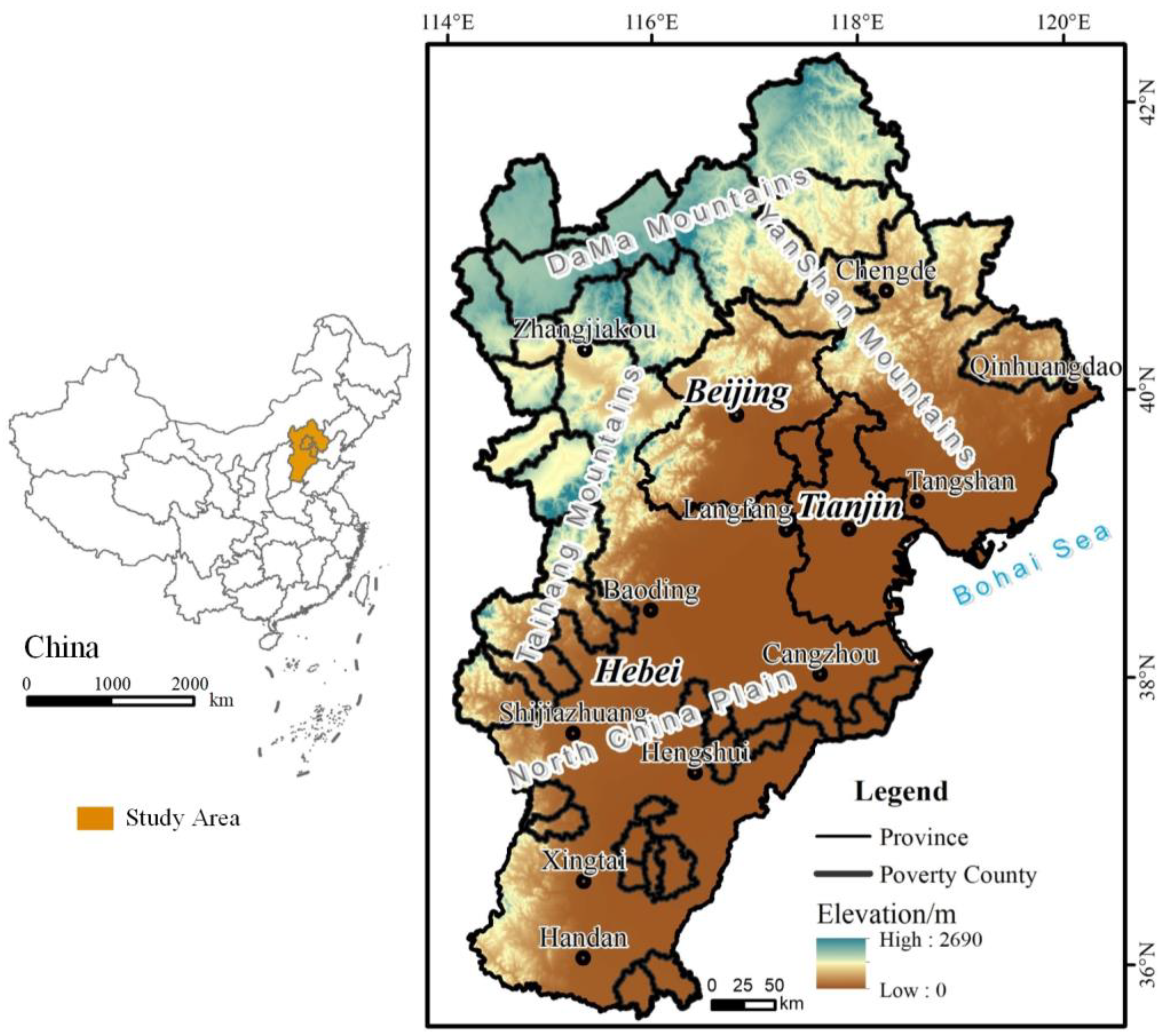
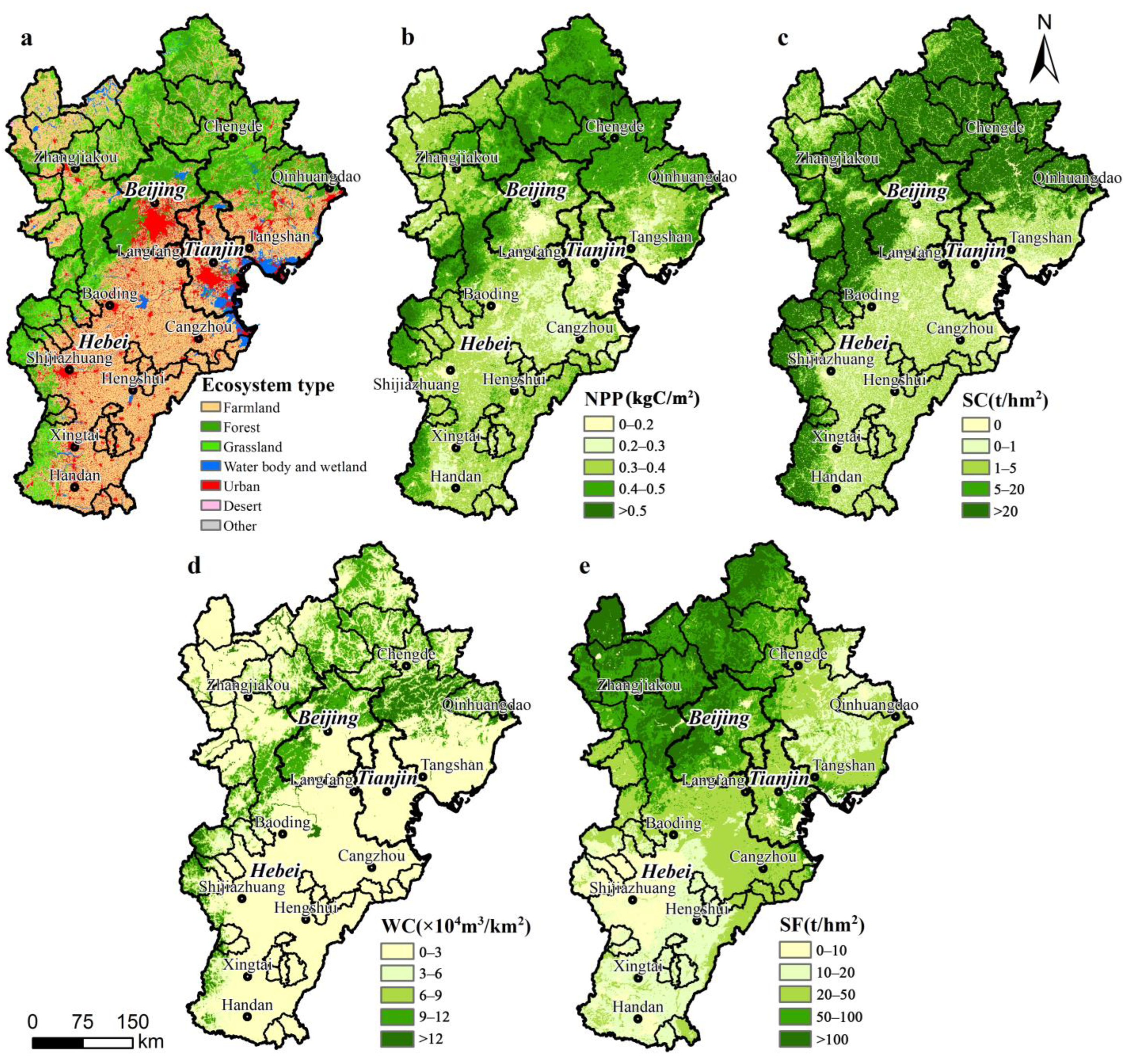
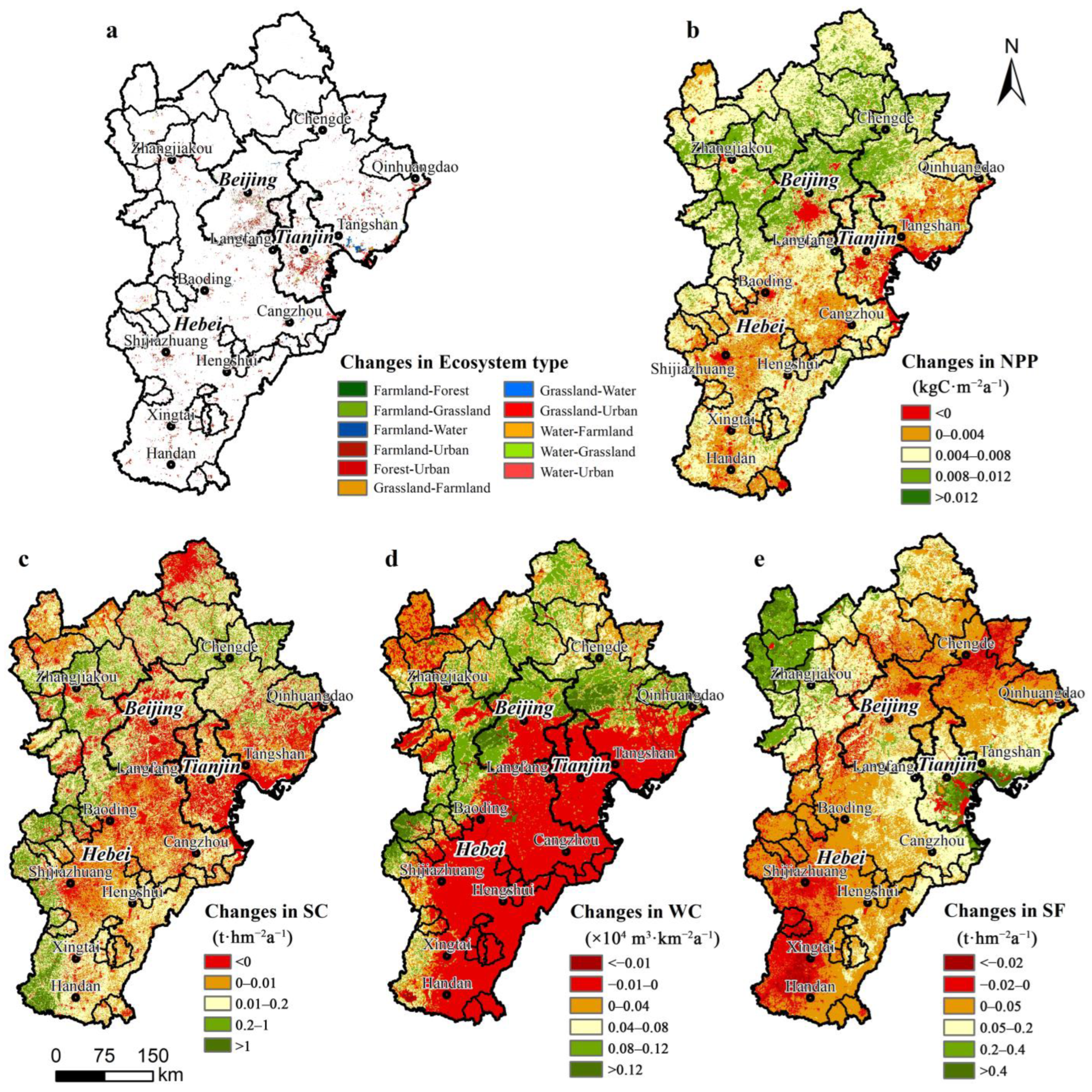
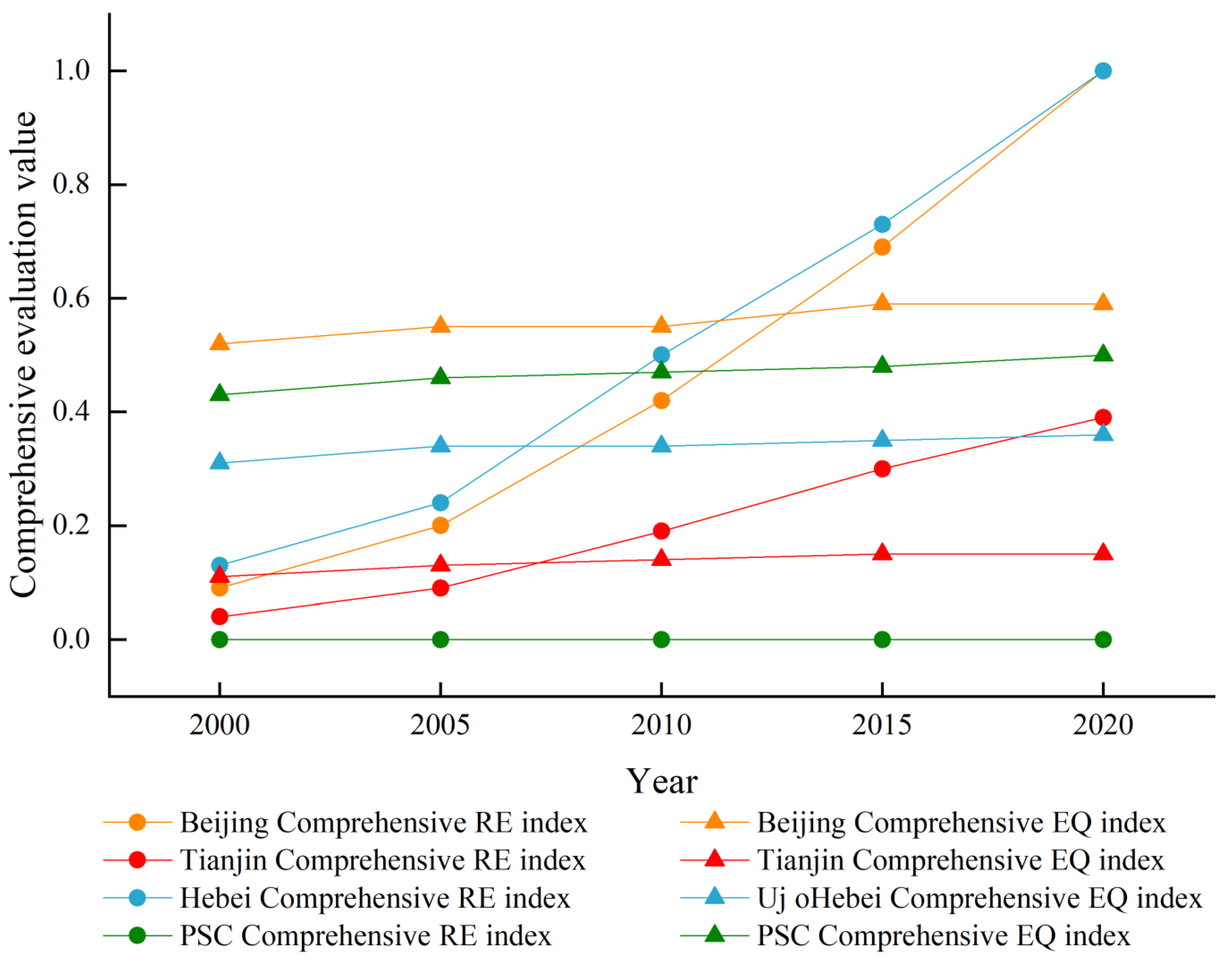

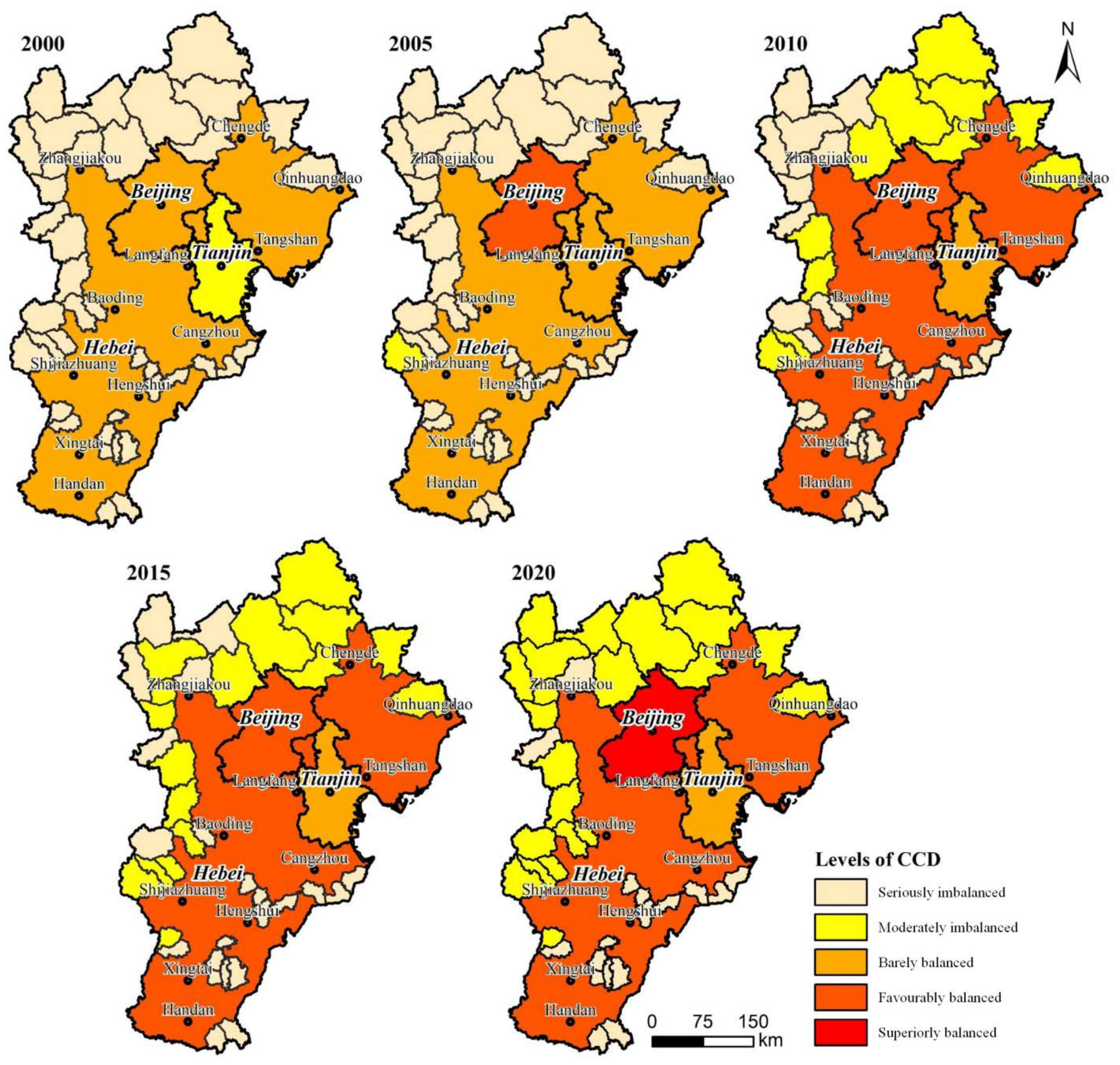
| Data Name | Dataset | Data Type and Format | Spatial Resolution or Scales | Data Periods | Data Sources |
|---|---|---|---|---|---|
| Socioeconomic statistics | GDP | Text data | / | 2000, 2005, 2010, 2015, 2020 | http://tjj.hebei.gov.cn (accessed on 31 January 2024) https://www.stats.gov.cn/sj/ndsj (accessed on 31 January 2024) |
| population data | Text data | / | 2000, 2005, 2010, 2015, 2020 | ||
| LUCC data | LUCC dataset | Raster/tiff | 30 m | 2000, 2005, 2010, 2015, 2020 | https://www.resdc.cn (accessed on 31 January 2024) |
| NPP data | MODI7A3 dataset | Raster/tiff | 1 km | 2000–2020 | |
| Soil data | China Soil Science Database | Polygon/ Shapefile | 1:1,000,000 | 1995 | |
| Annual precipitation data | Meteorological Daily Values Observed | Text data | / | 2000–2020 | http://data.cma.cn (accessed on 31 January 2024) |
| Evaluation Target Layer | Evaluation Indicator Layer | Weight | |
|---|---|---|---|
| RE | GDP (billion Yuan) | 1 | |
| EQ | Ecosystem structure | Proportion of high-quality ecosystem area (%) | 0.185 |
| Supply service | NPP (Tg) | 0.076 | |
| Regulatory services | Soil conservation (106 t) | 0.279 | |
| Water conservation (108 m3) | 0.266 | ||
| Sand fixation (108 t) | 0.194 | ||
| Index of CCD | Coupled Coordinated Development Level |
|---|---|
| 0–0.10 | Seriously imbalanced |
| 0.10–0.20 | Moderately imbalanced |
| 0.20–0.40 | Barely balanced |
| 0.40–0.60 | Favourably balanced |
| 0.60–1.00 | Superiorly balanced |
| Type | Beijing | Tianjin | Hebei | PSC | ||||
|---|---|---|---|---|---|---|---|---|
| Total | Proportion (%) | Total | Proportion (%) | Total | Proportion (%) | Total | Proportion (%) | |
| GDP (CNY billion) | 3610.22 | 41.79 | 1408.37 | 16.30 | 3620.69 | 41.91 | 394.82 | 4.57 |
| Farmland (106 km2) | 3.30 | 3.67 | 5.28 | 5.88 | 81.24 | 90.45 | 29.48 | 32.82 |
| Forest (106 km2) | 6.73 | 16.49 | 0.42 | 3.70 | 33.67 | 82.47 | 22.19 | 54.34 |
| Grassland (106 km2) | 1.13 | 3.70 | 0.28 | 0.90 | 29.13 | 95.39 | 19.08 | 62.49 |
| Wetland (106 km2) | 0.39 | 5.16 | 1.80 | 23.54 | 5.45 | 71.30 | 1.98 | 25.95 |
| Urban land(104 km2) | 3.21 | 12.68 | 2.96 | 11.72 | 19.12 | 75.60 | 3.93 | 15.55 |
| Deserts (104 km2) | 0 | 0 | 0.04 | 12.53 | 0.27 | 87.47 | 0.25 | 83.15 |
| Other (104 km2) | 0 | 1.72 | 0 | 10.98 | 0.04 | 87.30 | 0.02 | 53.95 |
| High-quality ecosystems (106 km2) | 8.26 | 10.45 | 2.50 | 3.16 | 68.25 | 86.38 | 43.24 | 54.74 |
| NPP (Tg) | 5.84 | 7.47 | 2.93 | 3.75 | 69.32 | 88.78 | 35.09 | 44.94 |
| Soil conversation (108 t) | 1.17 | 14.36 | 0.06 | 0.79 | 6.93 | 84.85 | 4.18 | 51.19 |
| Water conversation (108 m3) | 9.89 | 13.00 | 0.55 | 0.73 | 65.67 | 86.28 | 41.10 | 53.99 |
| Sand fixation (108 t) | 1.36 | 12.44 | 0.48 | 4.41 | 9.11 | 83.15 | 6.00 | 54.76 |
| Type | Beijing | Tianjin | Hebei | PSC | ||||
|---|---|---|---|---|---|---|---|---|
| Net Changes | Proportion (%) | Net Changes | Proportion (%) | Net Changes | Proportion (%) | Net Changes | Proportion (%) | |
| GDP (CNY billion) | 3282.44 | 42.69 | 1249.20 | 16.25 | 3157.87 | 41.07 | 341.93 | 4.45 |
| Farmland (104 km2) | −59.56 | 14.92 | −74.03 | 18.54 | −265.63 | 66.54 | −37.21 | 9.32 |
| Forest (104 km2) | 1.98 | 9.94 | 2.60 | 13.05 | −15.34 | 77.01 | −8.65 | 43.42 |
| Grassland (104 km2) | 4.79 | 13.69 | 4.78 | 13.66 | −25.42 | 72.65 | −17.09 | 48.84 |
| Wetland (104 km2) | −3.43 | 3.78 | −55.57 | 61.24 | −31.74 | 34.98 | −0.36 | 0.40 |
| Urban land (104 km2) | 56.22 | 10.93 | 118.04 | 22.96 | 339.92 | 66.11 | 65.83 | 12.80 |
| Deserts (104 km2) | 0.00 | 0.00 | 3.80 | 90.69 | −0.39 | 9.31 | −0.94 | 22.43 |
| Other (104 km2) | −0.07 | 1.33 | 0.26 | 4.92 | −4.95 | 93.75 | −1.89 | 35.80 |
| High-quality ecosystems (104 km2) | 3.34 | 2.69 | −48.19 | 38.85 | −72.5 | 58.45 | −26.1 | 21.04 |
| NPP (Tg) | 2.87 | 9.35 | 1.24 | 4.04 | 26.57 | 86.60 | 12.97 | 42.28 |
| Soil conversation (106 t) | −1.46 | 2.93 | −0.03 | 0.06 | 48.31 | 97.01 | 19.83 | 39.82 |
| Water conversation (108 m3) | 2.03 | 10.50 | 0.02 | 0.10 | 17.29 | 89.40 | 12.63 | 65.31 |
| Sand fixation (108 t) | 0.03 | 6.67 | 0.07 | 15.56 | 0.35 | 77.78 | 0.19 | 42.22 |
Disclaimer/Publisher’s Note: The statements, opinions and data contained in all publications are solely those of the individual author(s) and contributor(s) and not of MDPI and/or the editor(s). MDPI and/or the editor(s) disclaim responsibility for any injury to people or property resulting from any ideas, methods, instructions or products referred to in the content. |
© 2024 by the authors. Licensee MDPI, Basel, Switzerland. This article is an open access article distributed under the terms and conditions of the Creative Commons Attribution (CC BY) license (https://creativecommons.org/licenses/by/4.0/).
Share and Cite
Na, R.; Xu, X.; Wang, S. Spatiotemporal Analysis of Economic and Ecological Coupled Coordination: A Case Study of the Beijing–Tianjin–Hebei Urban Agglomeration. Land 2024, 13, 1138. https://doi.org/10.3390/land13081138
Na R, Xu X, Wang S. Spatiotemporal Analysis of Economic and Ecological Coupled Coordination: A Case Study of the Beijing–Tianjin–Hebei Urban Agglomeration. Land. 2024; 13(8):1138. https://doi.org/10.3390/land13081138
Chicago/Turabian StyleNa, Rigala, Xinliang Xu, and Shihao Wang. 2024. "Spatiotemporal Analysis of Economic and Ecological Coupled Coordination: A Case Study of the Beijing–Tianjin–Hebei Urban Agglomeration" Land 13, no. 8: 1138. https://doi.org/10.3390/land13081138





